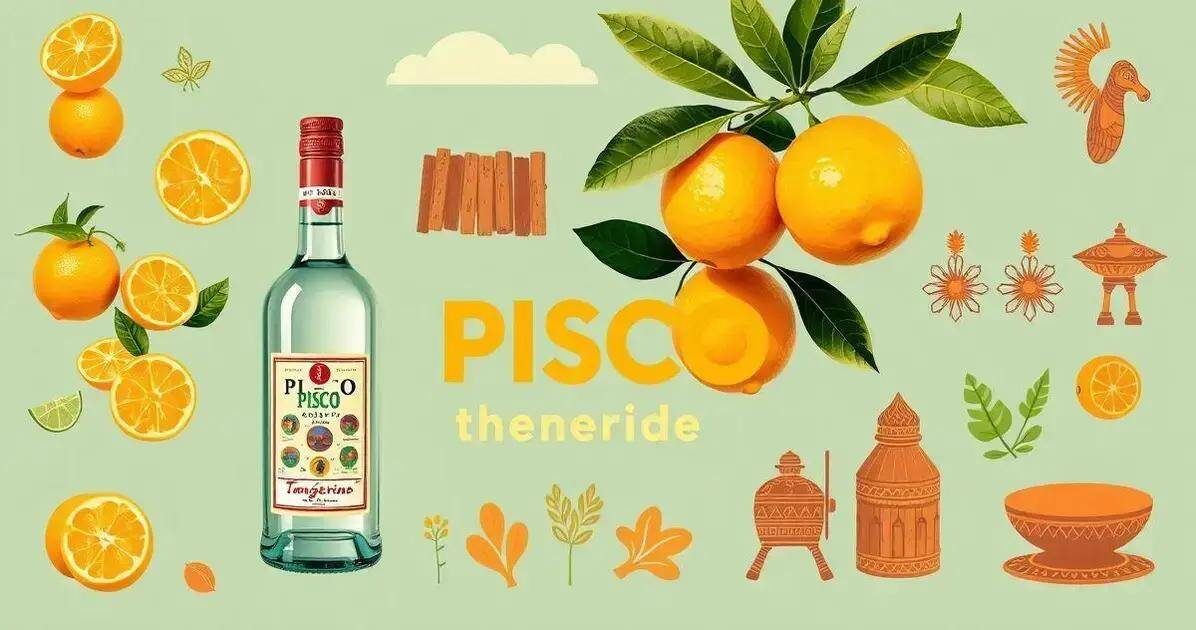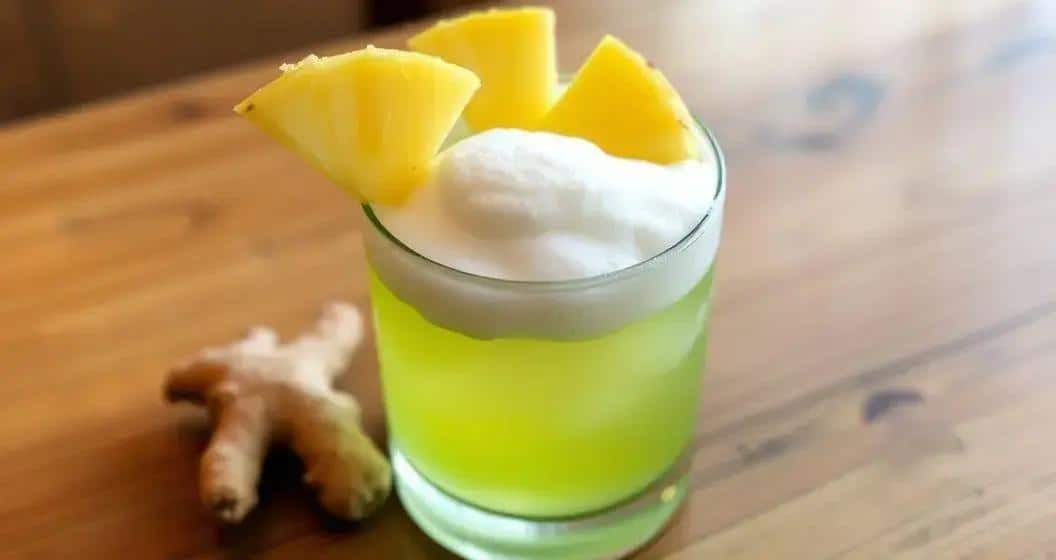Pisco with tangerine soda and cinnamon is a refreshing cocktail that beautifully balances the vibrant acidity of tangerines with the smooth richness of Pisco, creating a delightful drink perfect for any occasion.
Discover the unique blend of flavors in this refreshing cocktail made with pisco, tangerine soda, and cinnamon. Perfect for gatherings or a relaxing evening at home, this drink combines the vibrant zest of tangerine with the warmth of cinnamon, creating a standout beverage. Follow this guide for a detailed look at the recipe, its origins, and tips for the best preparation.
Summary
- 1 Recipe Ingredients for Pisco with Tangerine Soda and Cinnamon
- 2 Preparation Method for the Ultimate Pisco Cocktail
- 3 Recipe Curiosities about Pisco and Tangerine
- 4 Benefits of Using Fresh Ingredients in Cocktails
- 5 The History of Pisco: From Peru to Your Glass
- 6 Tips for Serving Pisco with Tangerine Soda and Cinnamon
- 7 Cheers to Your New Favorite Cocktail!
- 8 FAQ – Frequently Asked Questions About Pisco with Tangerine Soda and Cinnamon
Recipe Ingredients for Pisco with Tangerine Soda and Cinnamon
To create the delightful Pisco with Tangerine Soda and Cinnamon, you will need a few simple yet flavorful ingredients. Here’s what you will need:
Ingredients:
- 2 oz Pisco: Choose a good quality pisco for the best flavor. This Peruvian brandy is made from distilled grape juice.
- 4 oz Tangerine Soda: Use a fresh, carbonated tangerine soda to add sweetness and zest. You can also use homemade tangerine syrup mixed with soda water if you prefer.
- 1/2 tsp Ground Cinnamon: This spice is essential for adding a warm, aromatic touch to the cocktail.
- Ice Cubes: To serve the drink chilled, add plenty of ice cubes.
- Tangerine Wedge: For garnish, a tangerine wedge enhances the drink’s appearance and adds a pop of color.
- Cinnamon Stick: Optional, but using a cinnamon stick as a stirrer enhances the flavor during the drink.
These ingredients come together to create a vibrant and refreshing cocktail that pleases the palate and is perfect for any occasion.
Preparation Method for the Ultimate Pisco Cocktail
To prepare the Pisco with Tangerine Soda and Cinnamon, follow these simple steps:
- Gather Your Ingredients: Ensure you have all the ingredients ready and at your workstation. This includes pisco, tangerine soda, ground cinnamon, ice, and garnishes.
- Fill the Glass with Ice: Take a tall glass and fill it with ice cubes to keep your drink cold.
- Pour the Pisco: Measure and pour 2 ounces of pisco over the ice in the glass, allowing the crisp flavor to settle in.
- Add the Tangerine Soda: Slowly pour 4 ounces of tangerine soda into the glass to enhance the cocktail’s fruity essence.
- Sprinkle the Cinnamon: Add 1/2 teaspoon of ground cinnamon on top of the mixture. This will infuse the drink with a warm, aromatic flavor.
- Stir Gently: Use a spoon or cinnamon stick to stir the mixture gently, allowing the flavors to meld without losing the carbonation.
- Garnish: Finish off your drink by adding a tangerine wedge and a cinnamon stick for garnish. These welcome touches make the presentation pop.
Your ultimate pisco cocktail is now ready to be enjoyed! Sip and savor the refreshing blend of flavors.
Recipe Curiosities about Pisco and Tangerine
Here are some intriguing curiosities about Pisco and Tangerine that you may not know:
- Pisco’s Origins: Pisco is a spirit that hails from Peru and Chile, but it is most associated with Peru. Its production dates back to the 16th century, making it a historical treasure.
- Types of Pisco: There are several types of pisco, including Pisco puro, Pisco aromático, and Pisco acholado. Each type has its own distinct flavor profile, driven by the variety of grapes used for distillation.
- Benefits of Tangerines: Tangerines are not only delicious but also rich in vitamin C and antioxidants. They can boost your immune system and improve skin health.
- Cultural Significance: In Peru, Pisco is more than just a drink; it is part of the national identity. The country even holds a national holiday, “Día del Pisco Sour,” to celebrate this beloved cocktail.
- Creating Flavor Harmony: The combination of citrusy tangerines with the rich, smooth flavors of pisco creates a unique balance that enhances the enjoyment of each sip. This is why tangerine soda is a popular mixer.
- Mixology Innovation: Bartenders around the world are experimenting with Pisco, mixing it with various fruit juices, including tangerine, to create refreshing cocktails that showcase its versatility.
These fun facts not only enhance your knowledge about the ingredients but also deepen your appreciation for this delightful cocktail.
Benefits of Using Fresh Ingredients in Cocktails
Using fresh ingredients in cocktails offers numerous benefits that elevate the drinking experience. Here are some key advantages:
- Enhanced Flavor: Fresh ingredients like fruits and herbs enhance the flavor profile of cocktails. They provide natural sweetness and acidity that dried or artificial substitutes can’t match.
- Vibrant Colors: Fresh fruits and herbs add visual appeal to cocktails, making them more inviting. A colorful drink is more appetizing and catches the eye.
- Health Benefits: Fresh ingredients, especially fruits like tangerines, are full of vitamins and antioxidants. Using them in cocktails means you get added health benefits while enjoying your drink.
- Natural Aromas: Fresh herbs or citrus slices release delightful aromas, stimulating the senses and enhancing the overall drinking experience.
- Environmental Contribution: Opting for locally sourced fresh ingredients reduces environmental impact and supports local farmers. This practice promotes sustainability.
- Mixology Creativity: Fresh ingredients inspire creativity in mixology. Bartenders can experiment with different combinations, leading to innovative cocktails that surprise and delight.
Incorporating fresh ingredients not only improves the taste and presentation of cocktails but also contributes to a healthier and sustainable lifestyle.
The History of Pisco: From Peru to Your Glass
The history of Pisco is rich and storied, deeply connected to the cultural heritage of Peru. It originated in the 16th century when Spanish settlers brought grapevines to South America. The spirit is produced by distilling fermented grape juice, which makes it a type of brandy.
Pisco’s name is derived from the town of Pisco, located on the southern coast of Peru. This area was chosen due to its suitable climate for growing grapes, which led to the development of the unique Pisco production methods we know today.
In its early days, Pisco was used not only as a beverage but also as a medicinal tonic. As the spirit’s popularity grew, local distillers began to refine their techniques and enhance the flavor profiles. By the 19th century, Pisco had become an iconic Peruvian drink, loved by locals and visitors alike.
The spirit is protected by appellation laws, meaning true Pisco can only come from designated areas in Peru and Chile. This legal protection ensures that the quality and authenticity of the product are maintained.
Today, Pisco is celebrated worldwide, often enjoyed in cocktails like the classic Pisco Sour or, as featured in this article, paired with tangerine soda and cinnamon. This evolution from a local spirit to an international favorite showcases the enduring allure of Pisco.
Tips for Serving Pisco with Tangerine Soda and Cinnamon
Here are some valuable tips for serving Pisco with Tangerine Soda and Cinnamon to ensure a delightful experience:
- Choose the Right Glass: Use a tall, clear glass to showcase the vibrant colors of the cocktail. A highball glass works well for this mix.
- Chill Your Ingredients: Make sure your Pisco and tangerine soda are chilled before preparation. This keeps the drink refreshing and enjoyable.
- Use Fresh Ingredients: Always opt for fresh tangerine soda and high-quality Pisco. Fresh ingredients enhance flavor and make the cocktail more enjoyable.
- Presentation Matters: Garnish your drink with a tangerine slice on the rim and a sprinkle of cinnamon on top. This adds visual appeal and enhances the aromatic experience.
- Serve Immediately: Serve the cocktail right after preparing it to maintain its freshness and fizz. The carbonation is crucial for the texture of the drink.
- Experiment with Ratios: Feel free to adjust the ratio of Pisco to tangerine soda according to personal taste. Some may prefer a stronger Pisco flavor, while others might like it sweeter.
- Pair with Snacks: Consider serving the cocktail with snacks like light appetizers or citrusy treats. This complements the flavors of the drink.
Following these tips can elevate your cocktail experience, making it a memorable treat for you and your guests.
Cheers to Your New Favorite Cocktail!
Thank you for exploring the delightful world of Pisco with Tangerine Soda and Cinnamon with us! We hope you enjoy mixing this refreshing drink as much as we enjoyed sharing it.
Stay connected for more exciting recipes, tips, and cocktail inspirations. Don’t forget to follow us on our social networks! Join the fun at the Portal of Drinks and Cocktails Master of Drinks, your go-to source for all things drinks and cocktails. Cheers to great cocktails and good company!
FAQ – Frequently Asked Questions About Pisco with Tangerine Soda and Cinnamon
What is Pisco?
Pisco is a type of brandy made from fermented grape juice, originating from Peru and Chile.
Why is tangerine soda used in this cocktail?
Tangerine soda adds a refreshing citrus flavor that complements the smoothness of Pisco, creating a delightful drink.
Can I use fresh tangerines instead of tangerine soda?
Yes! You can use fresh tangerine juice mixed with soda water for a more natural taste.
What type of glass should I use for serving?
A tall highball glass is recommended to showcase the vibrant colors of the cocktail.
How can I make this cocktail sweeter or stronger?
You can adjust the ratio of Pisco to tangerine soda to your liking; add more soda for sweetness or more Pisco for strength.
Is Pisco gluten-free?
Yes, Pisco is made from grapes and is naturally gluten-free, making it suitable for those with gluten sensitivities.









